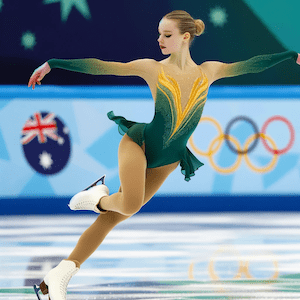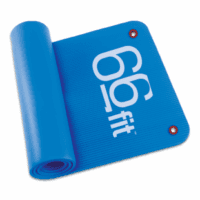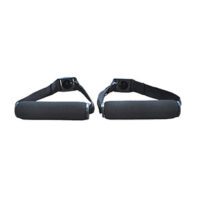Ice Skating Injuries
Article by John Miller

Ice Skating Injuries
Ice skating, blending balance, flexibility, and strength, captivates with its beauty and thrill. However, it’s not without ice skating injuries risks, ranging from bruises to more serious issues like concussions, fractures and ligament damage. These risks affect recreational and competitive skaters, particularly during complex movements like jumps and spins.
Common Injuries and Physiotherapy Solutions
Falls on the hard ice surface often cause bruises or more severe injuries such as wrist fractures or knee damage. Repetitive movements in skating can lead to overuse injuries in joints, particularly the knees and hips. These joint injuries may manifest as ligament sprains or cartilage damage, often requiring careful management.
Foot injuries, including Achilles tendinopathy and plantar fasciitis, are also prevalent due to the tight skating boots, which can restrict movement and place additional stress on the feet and ankles.

Physiotherapy’s Role in Recovery and Prevention
Recent research in physiotherapy underscores the effectiveness of targeted exercises and rehabilitation protocols for these injuries. Strengthening and stabilising exercises play a vital role in the recovery of knee and ankle injuries. Physiotherapists also recommend specific stretches and mobility exercises to prevent overuse injuries. These exercises not only alleviate current symptoms but also contribute to preventing future injuries.
In addition to these exercises, physiotherapists utilise hands-on techniques such as soft tissue massage and joint mobilisation to manage pain and enhance recovery. These techniques improve circulation, reduce muscle tension, and increase joint mobility, facilitating a quicker return to ice skating.
Enhancing Balance and Proprioception
Balance and proprioception exercises form another crucial aspect of rehabilitation. Skaters, due to their sport’s nature, require excellent balance and body awareness. These exercises help in restoring confidence and control, critical for performing on ice. Furthermore, physiotherapists often incorporate sport-specific drills into the rehabilitation process. These drills ensure that the skater’s return to the ice is safe and effective, reducing the risk of re-injury.
Educating Skaters for Long-term Health
Lastly, education about injury prevention and proper skating techniques is an integral part of physiotherapy. Skaters learn about the importance of correct foot positioning, body alignment, and movement patterns, which are essential in preventing injuries common in ice skating. By understanding the mechanics of their sport, skaters can improve their performance and reduce the likelihood of future injuries.
Physiotherapists play a pivotal role in not only treating the injuries but also in educating skaters on maintaining optimal physical health. This comprehensive approach ensures that skaters can enjoy their sport with reduced risk and enhanced performance.
Preventative Measures and Skating Safety
Essential Warm-up and Training Protocols
To prevent injuries, it’s vital to warm up and stretch before skating. A proper warm-up increases blood flow to the muscles, reducing the risk of strains and sprains. Dynamic stretching, in particular, prepares the body for the specific movements involved in skating. Proper training and readiness assessment for new skills are essential. This includes gradually building up to more complex techniques and ensuring that the basics are mastered first.
Appropriate Gear and Attire for Safety
Skaters should wear appropriate attire, including well-fitted skates that provide adequate support to the ankles and feet. This reduces the likelihood of falls and related injuries. Additionally, protective gear such as wrist guards, knee pads, and helmets should be worn, especially by beginners or those attempting advanced manoeuvers.
Importance of Rest and Professional Care
Avoiding skating when injured or exhausted is crucial, as fatigue can impair judgment and physical coordination, increasing the risk of accidents. Rest and recovery are as important as the activity itself in preventing overuse injuries.
Having a first aid kit on hand is essential for addressing minor injuries immediately. In case of pain or injury, seeking professional medical care promptly can prevent further damage. Early intervention by a healthcare professional ensures appropriate management and a quicker return to the ice.
Nutrition and Environmental Awareness
Hydration and nutrition also play a significant role in injury prevention. Staying hydrated helps maintain peak physical performance, while a balanced diet provides the necessary nutrients for muscle recovery and energy.
Lastly, understanding the environment is key. Skaters should be aware of their surroundings, including other skaters, to avoid collisions. They should also be cautious of ice conditions, avoiding skating on thin or uneven ice, which can lead to falls and injuries.
Conclusion
Ice skating, while beautiful, poses inherent risks. By understanding common injuries, adopting preventive measures, and consulting a physiotherapist when needed, skaters can minimise injury risks and enjoy long-term participation in the sport.
What to Do?
Experiencing discomfort or injury from ice skating? It’s important to seek professional advice. A physiotherapist can offer personalised exercises, rehabilitation plans, and preventive strategies to safeguard your wellbeing and enhance your skating performance.
Related Articles
- Manual Physiotherapy Techniques – Offers a look into various manual therapy techniques that can be beneficial for treating sports injuries.
- Warming Up Exercises – Highlights the importance of proper warm-up routines to prevent injuries in physical activities like ice skating.
- Tendinopathies Overview – A comprehensive guide on tendinopathies, which can be a concern for ice skaters due to repetitive movements.
- Acute and Sub-Acute Injury Management – Offers insights into managing both immediate and short-term injuries that might occur in ice skating.
- Exercise Prescription for Rehabilitation – Details on how physiotherapy exercises can aid in the recovery from sports injuries.
- Sports Injury Management – A broader look at managing various sports injuries, applicable to ice skating.
- Physiotherapy Treatment: Strategies for Healing and Mobility – An overview of different physiotherapy treatments available for sports-related injuries.

















































































